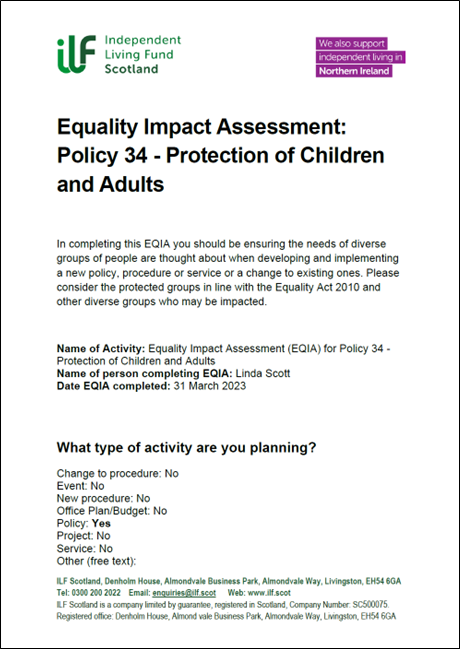
In completing this EQIA you should be ensuring the needs of diverse groups of people are thought about when developing and implementing a new policy, procedure or service or a change to existing ones. Please consider the protected groups in line with the Equality Act 2010 and other diverse groups who may be impacted.
Name of Activity: Equality Impact Assessment (EQIA) for Policy 34 - Protection of Children and Adults
Name of person completing EQIA: Linda Scott
Date EQIA completed: 31 March 2023
Change to procedure: No
Event: No
New procedure: No
Office Plan/Budget: No
Policy: Yes
Project: No
Service: No
Other (free text):
Policy and wording review.
All 2015 fund recipients.
The protected characteristics to consider are: Age, Disability, Sex, Race, Religion or Belief, Gender Reassignment, Sexual Orientation, Marriage and Civil Partnership, Pregnancy and Maternity. It will also be helpful to consider these groups more widely in relation to their socio-economic status that includes such factors as educational attainment, occupation, income, wealth and social deprivation.
Please mark as Yes or No. If yes use the Comments column to describe what the potential impact is. What are your sources of evidence?
(Try to think about both positive and negative impacts. There are lots of sources of data to help answer this question. Diversity Networks, the Diversity Report or Diversity & Inclusion team may offer some useful information. Previously completed EQIAs may also offer answers to questions you may have).
Age: No
Comments:
Disability: No
Comments:
Gender Reassignment: No
Comments:
Marriage and Civil Partnership: No
Comments:
Pregnancy and Maternity: No
Comments:
Race: No
Comments:
Religion or belief: No
Comments:
Sex: No
Comments:
Sexual orientation: No
Comments:
(For example, carer status, single parent, economic exclusion. It is important not to limit your thinking just to the protected characteristics listed above. This question is broadening the EQIA out to be more inclusive. The impact might be a negative one (e.g. making that decision could decrease the opportunity for some people to participate) or it could be a positive one (e.g. by making that decision, more people are able to take part in the activity).)
Carers: No
Comments:
If there are any gaps in information that make it difficult or impossible to form an opinion on how your policy, service or change might affect different groups of people, please take the time to gather information to help you make an informed answer (for example, review statistics, survey results, complaints analysis, consultation documents, customer feedback, existing briefings submissions or business reports, comparative policies from external sources and other Government Departments etc).
Desk research, consultation with ILFS Assessors, Specialist Caseworkers, Recipients, Award Managers, Scottish Advisory Group, NI Stakeholder Group.
Age: No
Disability: No
Gender Reassignment: No
Marriage and Civil Partnership: No
Pregnancy and Maternity: No
Race: No
Religion or belief: No
Sex: No
Sexual orientation: No
No adverse impact determined
Age: Yes
Comments: Recipients are an aging population, and current research indicates that almost half a million people aged over 65 in the UK will experience some form of abuse or neglect.
Sources: https://www.who.int/news-room/fact-sheets/detail/abuse-of-older-people and Elder Abuse - Age Concern Scotland
Disability: Yes
Comments: All recipients live with significant health conditions / impairments, with evidence indicating disabled people experience higher rates of domestic violence and sexual assault than non-disabled people. 70% of disabled people in the UK have experienced some form of abuse and are three times more likely to be sexually assaulted.
Sources: The Links Between Disability & Domestic Violence - Sanctuary For Families and Unequal, Unheard, Unjust: But not Hidden Anymore – new report launched at Scotland’s Learning Disability and Gender-Based Violence Conference 2023 - SCLD
Gender Reassignment: Yes
Comments: While the number of recipients who have undergone gender reassignment is not known, the evidence indicates those who are transitioning to another gender are more likely to experience harassment and abuse.
Sources: https://www.copfs.gov.uk/media/d3jnt5t2/hate-crime-2021-22-publication-final.pdf
Marriage and Civil Partnership: No
Pregnancy and Maternity: No
Race: Yes
Comments: Racial abuse and discrimination are indicated as the most commonly reported crime to police in Scotland.
Sources: https://www.copfs.gov.uk/media/d3jnt5t2/hate-crime-2021-22-publication-final.pdf and https://www.gov.scot/publications/recorded-crime-scotland-year-ending-december-2022/
Religion or belief: Yes
Comments: Religion or belief (including perceived) have been identified in research and statistics as a common reason individuals are harassed, abused and discriminated against.
Sources: https://www.gov.scot/publications/scottish-government-equality-outcomes-religion-belief-evidence-review/pages/8/, hate-crime-2021-22-publication-final.pdf (copfs.gov.uk) and https://www.gov.scot/publications/recorded-crime-scotland-year-ending-december-2022/
Sex: Yes
Comments: Evidence highlights that abuse and neglect are more likely to be experience by females, with disabled females experiencing the highest rates of abuse overall in the UK.
Sources: https://safelives.org.uk/knowledge-hub/spotlights/spotlight-2-disabled-people-and-domestic-abuse and Disability and Domestic Abuse - Risk, impacts and response
Sexual orientation: Yes
Comments: The sexual orientation of recipients is not known, however research indicates that LGBTQ+ people are more likely to experience abuse and harassment.
Sources: https://www.copfs.gov.uk/media/d3jnt5t2/hate-crime-2021-22-publication-final.pdf and https://www.scottishwomensrightscentre.org.uk/information-lgbtq/
Policy 34 sets out how ILF Scotland will promote the protection of children and adults, provides a definition of the different types of abuse that can be experienced, and details what ILF Scotland staff will do to ensure children and adults are protected from harm. As recipient characteristics are identified as increasing the risk of harm, Policy 34 has a positive impact by ensuring awareness, protection and action should abuse be identified or suspected. While no 2015 recipients are under the age of 18, children are included in the policy to ensure that should abuse or neglect be suspected or identified they are equally protected.
We will continue to discuss with and inform Recipients / Award Managers of this policy via our website, and contact with our Assessors and Specialist Caseworkers, Scottish Advisory Group and NI Stakeholder Group.
Ongoing monitoring and review of policy impact on Recipients and their Award Manager via feedback from Assessors and Specialist Caseworkers, Management Team, and Senior Management Team. Policy will be signed off by Linda Scott, Director of Policy, Improvement and Engagement.